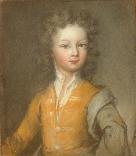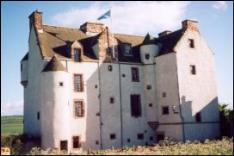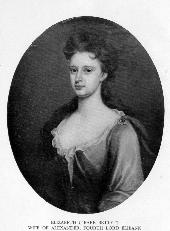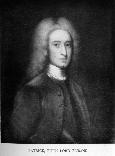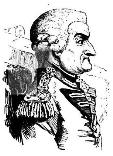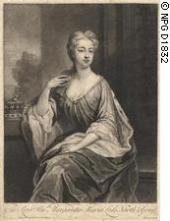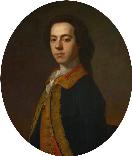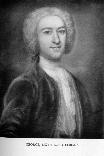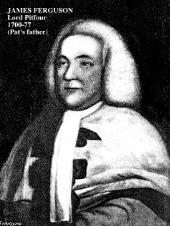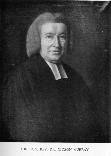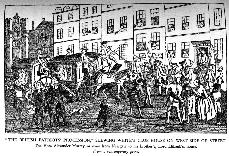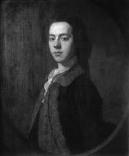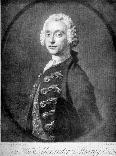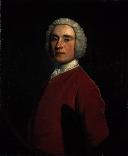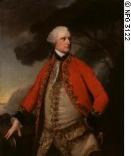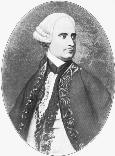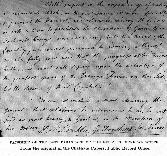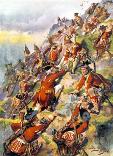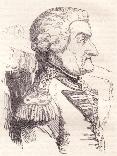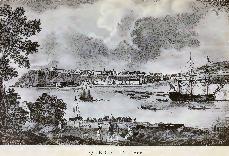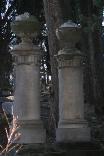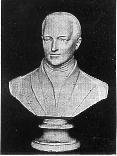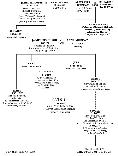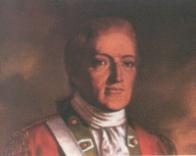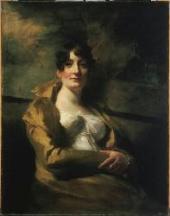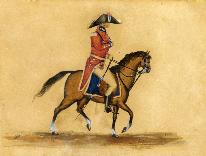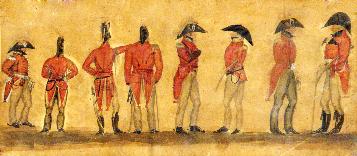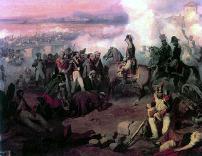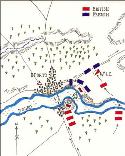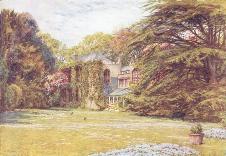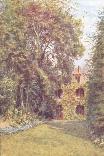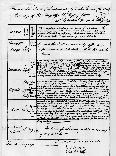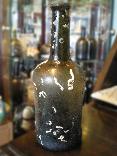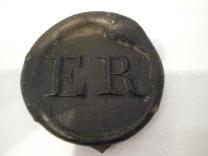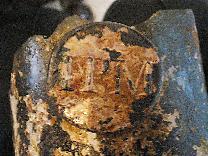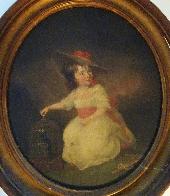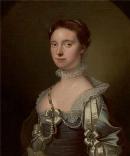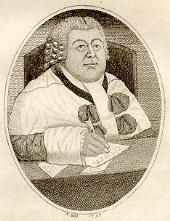See also
- Alexander MURRAY's parents: Patrick 3rd MURRAY (bef1661-1687) and Anna BURNET ( - )
- Alexander MURRAY's siblings: Anna MURRAY (1679- ), Mary MURRAY (1681- ), Helen MURRAY (1683- ) and Elizabeth MURRAY ( - )
Alexander MURRAY 4th Lord Elibank (1677-1735)
1. Alexander MURRAY 4th Lord Elibank, son of Sir Patrick 3rd MURRAY 3rd Lord Elibank (bef1661-1687) and Anna BURNET ( - ), was born on 9 March 1677. He was a 4th Lord Elibank. He had the title '4th Lord Elibank'. He married Elizabeth STIRLING in February 1698. He died on 6 February 1735.
Sir Alexander became 4th Lord Elibank on his father's death in 1686, when he was nine years old. He had 15 children of whom 5 sons and 5 daughters survived him.
As a matter of interest, the Lord of Elibank voted for the Union of the Scottish and English Parliaments in Edinburgh in 1706-1707. He also recieved ?0 for doing so. This information was stated by The Earl of Glasgow, on oath, and by David Nairne, Secretary Deputy of Scotland. What a price for Scotland's freedom!
Alexander and his family had many financial problems, and the depletion of the family fortunes to the Stuart coffers was further exacerbated by the Fourth Earl losing heavily in the South Sea Bubble. He wrote to his wife about this - "I am infinitely vexed that you should torment yourself so much, which I assure you is more galling to me than any misfortune that has yet befallen me. As I shall answer God I have never bought a farthing's worth of stock but that third subscription, nor you may depend upon it will I venture a groat more that way, for now the South Sea has fallen to its primitive 110 this day (it stood at 1,000 a few days previously) so that it seems now past all recovery; what parliament will be able to do with it I cannot tell".
At the time, the Scottish Nobility was also in a generally impoverished state, and so Elibank's situation was not by any means unique.
Alexander devoted much of his life to the (succesful) reform of agriculture in Scotland, and was a founder of the "Society of Improvers in the knowledge fo Agriculture in Scotland".
Alexander was clearly loved and respected by both friends and family, and his son Patrick wrote of him: "My father, Alexander, Lord Elibank, died of what the Phisicians called the gout in his stomach on the 6th of February, 1736, The following character was given him in the common newspapers - "He lived esteemed and beloved by men of all ranks and parties and his death is universally lamented. No man ever surpassed himin the practice of every social virtue, he was a fond Husband, and indulgent Parent, and an unalterable friend, and as he never had an enemy he never was accused or suspected of anyone. Never was there a juster character"".
Elizabeth STIRLING, daughter of George STIRLING ( - ), was born before 1683. She appeared in the census. She died on 11 November 1756. She and Alexander MURRAY had the following children:
| +2 | |
| +3 | |
| +4 | |
| +5 | |
| +6 | |
| +7 | |
| +8 | |
| +9 | |
| +10 | |
| +11 | |
| +12 | |
| +13 | |
| +14 |
Second Generation
2. Elizabeth MURRAY, daughter of Alexander MURRAY 4th Lord Elibank and Elizabeth STIRLING, was born on 26 August 1701. She was baptised on 27 August 1701. She died on 19 March 1748 in Edinburgh.
She was unmarried.
3. Sir Patrick MURRAY 5th Lord Elibank, son of Alexander MURRAY 4th Lord Elibank and Elizabeth STIRLING, was born on 27 February 1703. He had the title '5th Lord Elibank, Earl of Westminster'. He married Margaretta Maria DE JONGE in 1735. He died on 3 August 1778 in Ballencrieff Castle in Haddingtonshire near Edinburgh.. He married Mary MORTLOCK.
Sir Patrick was a wit, raconteur and friend of Dr. Johnson. He succeeded to the title as 5th Lord, and was also Lieutenant-Colonel in Wynyards Marines. He was a sometime member of the Cocoa Tree Club and The Poker Club.
Besides this, he was a Jacobite who had an involvement with the Elibank plot. "There was to be one more serious conspiracy against King George and his government, the Elibank Plot, which was penetrated and exploded in 1753 by the government led by Henry Pelham, heir to Walpole. The debacle cost the life of the last Jacobite martyr, Dr. Archie Cameron, younger brother to Lochiel, but really by 1753 Prince Charles, despite an expedient conversion to Anglicanism, was not politically viable".
A brilliant man of great knowledge Sir Patrick wrote Essays on Paper Money, Banking, etc. (1755) Thoughts on Money, Circulation, and Paper Currency (1758), Inquiry into the Origin and Consequence of the Public Debts (1758/9), Queries Relating to the Proposed Plan for Altering Entails in Scotland (1765), Letter to Lord Hailes on his Remarks on the History of Scotland (1773) and Considerations on the Present State of the Peerage of Scotland (1774). Alexander Carlyle, in his autobiography, described Lord Elibank as one of the most learned and ingenious noblemen of his time, and as having a mind that embraced the greatest variety of topics and produced the most original remarks.
Details of his connection with James Boswell:
Boswell was with him on 26/11-62 at Lord Eglinton's, describing him as a man of great genius, great knowledge, and much whim. Boswell had a conversation with Lord Elibank in the company of Lord Eglinton, James Macdonald and Thomas Sheridan, mentioned in LJ 291162.
Boswell and Johnson also visited the Lord during their 1773 tour of the Hebrides.
Sir Patrick was a wit, raconteur and friend of Dr. Johnson. He succeeded to the title as 5th Lord, and was also Lieutenant-Colonel in Wynyards Marines. He was a sometime member of the Cocoa Tree Club and The Poker Club. Besides this, he was a Jacobite who had an involvement with the Elibank plot. "There was to be one more serious conspiracy against King George and his government, the Elibank Plot, which was penetrated and exploded in 1753 by the government led by Henry Pelham, heir to Walpole. The debacle cost the life of the last Jacobite martyr, Dr. Archie Cameron, younger brother to Lochiel, but really by 1753 Prince Charles, despite an expedient conversion to Anglicanism, was not politically viable". A brilliant man of great knowledge, Sir Patrick wrote "Essays on Paper Money, Banking, etc. "(1755) "Thoughts on Money, Circulation, and Paper Currency" (1758), "Inquiry into the Origin and Consequence of the Public Debts "(1758/9), "Queries Relating to the Proposed Plan for Altering Entails in Scotland"(1765), "Letter to Lord Hailes on his Remarks on the History of Scotland" (1773) and "Considerations on the Present State of the Peerage of Scotland "(1774). Alexander Carlyle, in his autobiography, described Lord Elibank as one of the most learned and ingenious noblemen of his time, and as having a mind that embraced the greatest variety of topics and produced the most original remarks. He was a good friend of most notable men of letters of the time, including Boswell. In 1773 Boswell and Samuel Johnson visited Sir Patrick during a tour of the Hebrides. Lord Eglinton described him as a man of great genius, great knowledge and much whim.
Boswell was with him on 26/11-62 at Lord Eglinton's, describing him as a man of great genius, great knowledge, and much whim. Boswell had a conversation with Lord Elibank in the company of Lord Eglinton, James Macdonald and Thomas Sheridan, mentioned in LJ 291162.
Boswell and Johnson also visited the Lord during their 1773 tour of the Hebrides.
From the letters of Horace Walpole:
"Lord Cromartie was receiver of the rents of the King's second son in
Scotland, which, it was understood, he should not account for; and by
that means had six-hundred a-year from the Government: Lord Elibank, a very prating, impertinent Jacobite, was bound for him in nine thousand pounds, for which the Duke is determined to sue him".
MURRAY, PATRICK, fifth lord Elibank, a nobleman distinguished by erudition and literary taste, was the eldest son of Alexander, the preceding lord, by Elizabeth, daughter of George Stirling, surgeon in Edinburgh. He was born in February, 1703. For reasons with which we are unacquainted, he studied for the Scottish bar, at which he entered in 1723, but in the same year adopted the military profession, and soon rose to a considerable rank in the army. He was, in 1740, a lieutenant-colonel under lord Cathcart, in the expedition to Carthagena, of which he wrote an account, that remains in manuscript in the library of the Board of Trade. He had now succeeded to the family title, and was distinguished for his wit and general ability. His miscellaneous reading was extensive and we have the authority of Dr Johnson, that it was improved by his own observations of the world. He lived for many years at a curious old house, belonging to the family of North, at Catage in Cambridgeshire; and it has been recently ascertained that he kept up a correspondence with the exiled house of Stuart. In the latter part of his life, he appears to have chiefly resided in Edinburgh, mingling with the distinguished literati of the city, who were his contemporaries, and fully qualified by his talents and knowledge, to adorn even that society.
In 1758, he published at Edinburgh, "Thoughts on Money, Circulation, and Paper Currency;" and an "Inquiry into the Origin and Consequence of the Public Debts" appeared afterwards. In 1765, he issued "Queries relating to the proposed Plan for altering Entails in Scotland," and, in 1773, a "Letter to lord Hailes on his Remarks on the History of Scotland." His lordship’s political life was entirely that of an opposition lord, and, among other subjects which attracted his indignant attention, was the servile condition of his native peerage. In the year 1774, he published a work under the title of "Considerations on the Present State of the Peerage of Scotland," which attracted a considerable degree of attention. "Never," says he "was there so humbling a degradation as what the Scots peers of the first rank and pretensions suffer, by the present mode of their admittance to the house of lords. For the truth of this, one needs but to appeal to their own feelings, or to the common estimation of mankind. A Scots peer of the first rank is considered as an instrument singled out, and posted in the house of lords by the appointment of the minister at the time, for the end of supporting his measures, whatever they are or may be; and who, in case of failure, must expect to be turned out at the expiration of his term of seven years. He is supposed to be composed of such pliant materials, that in the event of a change of administration, the next minister makes no doubt of finding him equally obsequious, and ready to renounce his former connexions." When Dr Johnson visited Scotland in 1773, lord Elibank addressed to him a courteous letter, which is to be found in Boswell’s Tour to the Hebrides, where are also the records of various conversations in which both men flourished. The English philosopher declared that he never met his lordship, without going away a " wiser man." Lord Elibank in early life married the dowager lady North and Grey, who was by birth a Dutch-woman, and of illustrious extraction. He died, without issue, August 3, 1778, in the seventy-sixth year of his age.
Dr. Johnson quote: "Johnson characterized three orders of persons, in General Oglethorpe, Lord Elibank, and Burnet, Bishop of Salisbury. Oglethorpe never completed what he had to say; Elibank had nothing conclusive in his talk ; and Burnet took no pains to be right.".
Mary MORTLOCK and Patrick MURRAY had the following children:
| +15 |
Lady Margaretta Maria DE JONGE, daughter of Cornelis DE JONGE VAN ELLEMEET ( - ), had the title 'Lady Elibank'. She died on 6 June 1762. She and Patrick MURRAY had the following children:
| +16 |
4. Alexander MURRAY, son of Alexander MURRAY 4th Lord Elibank and Elizabeth STIRLING, was born on 23 July 1704. He died in 1705.
5. Admiral George MURRAY 6th Lord Elibank, son of Alexander MURRAY 4th Lord Elibank and Elizabeth STIRLING, was born on 14 May 1706 in Aberlady. He was an Admiral in the Navy. He had the title 'Admiral, 6th Lord Elibank'. He married Isabella MCKENZIE on 8 January 1760. He died on [Julian] 12 November 1785 in Ballencrieff.
George had a distinguished career in the Royal Navy serving under Admiral Anson, whom he accompanied in part of his famous voyage around the world, although some controversy surrounded the fact of Murray's separation from Anson's fleet in very difficult and dangerous circumstances in waters around Cape Horn, although Murray's position has been fully explained and his conduct completely exonerated by the Hon. Arthur C. Murray in his book "An Episode in the Spanish War". Geroge Murray commanded various ships including HMS Tryal,Wager,Pearl, Hampshire,and Revenge. He left the navy in 1756 and suceeded his brother Patrick as 6th Lord Elibank in 1788.
Pilot Darrell’s Square is named for Pilot James Darrell who was one of three slaves chosen to work with
Lieutenant Thomas Hurd when he surveyed the channels and harbours around Bermuda in the 1790s. In May
1795, James Darrell piloted Admiral George Murray’s ship, the 74-gun HMS Resolution, through the Narrows
Channel into the newly charted Murray’s Anhorage. Admiral Murray was so impressed with James Darrell’s
skill that he recommended to Governor James Craufurd that Pilot Darrell be granted his freedom. James
Darrell was owned by Frances Darrell of St. George’s, and when the latter died, James Darrell was purchased
by the Governor who gave him his freedom in accordance with Admiral Murray’s request. Pilot James Darrell
received his freedom in March 1796 at 47 years of age and became the first black man to purchase a house
in Bermuda. The house, which was renovated in 1992, still stands at Pilot Darrell’s Square and is owned by
James Darrell’s descendents. From Pilot Darrell’s Square there is a superb view of the bell tower at the
western end of St. Peter’s Church. This view is framed by Taylor House, one of the prettiest and most
photographed houses in St. George’s and by a massive chimney which is one of seven beautiful chimneys at
Stewart Hall.
Rear Admiral George Murray
In May 1794, after war was again declared in 1793 between Britain and France, more British naval vessels were needed in the western Atlantic to deter French privateers. Rear Admiral George Murray sailed from Plymouth, England, with a Royal Navy squadron. It reinforced the few frigates based at Halifax under Commodore Rupert George. Cruising that summer off the Chesapeake Bay and the Carolinas in search of French vessels, Murray needed a base for his patrols during the winter.
Lieutenant Thomas Hurd RN, A marine surveyor, had charted the waters of Canada's Atlantic and Gulf of St. Lawrence. He was sent to Bermuda, to sound existing channels through the reefs and find new ones prior to the building of a British naval base in Bermuda. He began his surveys in the late 1780s and completed them in 1792.
In early October that year, on his flagship HMS Resolution off the American coast, Murray was told of Lieutenant Hurd's surveys and findings in Bermuda and dispatched the 32 gun frigate Cleopatra, under Captain Penrose, to Bermuda to bring back a report and charts from Hurd. What they revealed impressed Murray so much that he called at Bermuda himself before his return to Halifax in the spring. Murray sent Penrose and the Cleopatra back to Bermuda in February, 1795, to pick up French prize crews, during which time Penrose made his own glowing report of the facilities Bermuda could offer. Murray ordered Penrose to rendezvous with him at Bermuda in May, 1795 and was so further impressed with what he saw personally, as well as in the reports of Captains Penrose and Pender (of HMS Resolution) and Lieutenant Hurd, that he enclosed them with his own report to the Admiralty dated May 27, 1795.
Isabella MCKENZIE, daughter of George MCKENZIE ( - ), died on [Julian] 28 December 1801 in Ross. She and George MURRAY had the following children:
| +17 | |
| +18 |
6. Anne MURRAY, daughter of Alexander MURRAY 4th Lord Elibank and Elizabeth STIRLING, was born on 20 September 1708. She married James FERGUSON on 3 February 1733 in Aberlady. She died on 2 January 1793.
From a letter to her brother, General Jon. James Murray:
"I have three girls, none of whom have any claims to the beauties of the body. Annie whom you visited in the Small Pox is of a low stature, and pretty much pitted without having her features altered by them. Betty is taller than I am, genteel enough and when in here good looks is thought by strangers to have a resemblance to my Sister Jannie; Jeanie who is of Annies size is in point of looks middling, but for a soul and genious I'll sett her loose with any she that ever stept in petticoats, she had cost me more trouble than all the rest, for her genious bewitched me, and some times got the better of my reason. But now, after Hunting, Riding, Shooting and Latin, I have got her brought to a moderate use of her needle, which with a little musick, bowling and chess, which I indulge her in, makes her turn out a good decent girl of sixteen. As to her dancing, its the Horn Pipe she excells in; but I must not conclude without assuring you that they are modest, virtuous girls, uncapable of lying of falsehood, and just the reverse of some others that you'll remember.".
James FERGUSON of Pitfour, son of James FERGUSON (1672-1734) and Anne STUART of Crichie (1669-1731), was born in 1700. He had the title '2nd of Pitfour'. He died on 25 June 1777 in Woolmet. He and Anne MURRAY had the following children:
| +19 | |
| +20 | |
| +21 | |
| +22 | |
| +23 | |
| +24 |
7. Revd. Gideon MURRAY, son of Alexander MURRAY 4th Lord Elibank and Elizabeth STIRLING, was born on 5 February 1710 in Ballencrieff. He was a Priest. He married Elizabeth MONTOLIEU DE ST. HYPPOLITE on [Julian] 30 June 1746 in London. He died on [Julian] 21 June 1776 in Wandsworth.
Appointed Chaplain-General to the Army, and Prebendary of the 3rd stall in Durham Cathedral. Was present with George II at the battle of Dettingen in 1743. Chaplain of 43rd (afterwards 42nd) Highlanders.
Elizabeth MONTOLIEU DE ST. HYPPOLITE, daughter of Sieur David Montolieu de St. HYPPOLITE ( - ), died on [Julian] 21 November 1677. She and Gideon MURRAY had the following children:
| +25 | |
| +26 |
8. John MURRAY, son of Alexander MURRAY 4th Lord Elibank and Elizabeth STIRLING, was born on 14 September 1711. He died on 31 December 1711.
9. Alexander MURRAY, son of Alexander MURRAY 4th Lord Elibank and Elizabeth STIRLING, was born on 9 December 1712 in Ballencrieff. He was christened on 9 December 1712 in Aberlady. He was a Politician. He had the title 'Jacobite Earl of Westminster'. He died on 27 February 1778 in Taplow, Bucks.
Alexander Murray developed into a well-known and vehement Jacobite, and refused to kneel to the House of Commons.
"Mr Alexander Murray was so enthusiastic a Jacobite as to propose leading an insurrection even after the close of all the just hopes of the house of Stuart in 1746. He was confined for more than a year subsequent to May 1750, by order of the house of commons, for violent interference with a Westminster election; and, as he refused to express contrition on his knees, according to the order of the house, he might have been confined for a much longer period, if the prorogation of parliament had not brought about his enlargement".
The Elibank Plot and Alexander Murray:
... Charles Edward [the Young Pretender] did not give up. He tried to persuade Louis XV to go to war again. Lochiel urged for another invasion in 1747 a year before his death in Flanders. There were other Jacobite plots later but none succeeded. The last Jacobite to be executed was Dr Archibald Cameron, Lochiel's brother, after Alexander Murray's Elibank Plot to abduct or assassinate the whole royal family was exposed by young MacDonell of Glengarry (the spy code named 'Pickle') in 1753. When George III succeeded his grandfather as King in 1760 he was accepted in a way his predecessors had not been. Unlike them - and unlike Charles Edward - he had even been born in Britain. The Old Pretender, James Francis, died in 1766. Charles Edward started calling himself Charles III but this meant little. He died in 1788 a disappointed drunkard. His younger brother Henry became a Cardinal. As Henry IX he died in 1807, recognising George III and his descendants as the lawful kings.
Alexander was an ensign in the 26th Foot (Cameronians) until taking up politics.
After refusal to kneel in the House of Commons was committed to Newgate Prison and was released by order of the Sherrifs of London when Parliament was prorogues.
He eventually went into exile in France and there was involved in the "Elibank Plot" to restore the Stewarts to the Throne. In 1759 was created Earl of Westminster by the Pretender (Chevalier de St. George, James Eighth and Third). He was recalled from exile under the King's Privy Seal in 1771 and died, unmarried, at Taplow in 1778.
10. Mary MURRAY, daughter of Alexander MURRAY 4th Lord Elibank and Elizabeth STIRLING, was born on 4 September 1714. She was baptised on 5 September 1714. She died on 18 June 1772.
She died unmarried.
11. Helen MURRAY, daughter of Alexander MURRAY 4th Lord Elibank and Elizabeth STIRLING, was born on 19 January 1716. She was baptised on 24 January 1716. She married John (James) STEWART on 12 September 1761 in Edinburgh. She died on 28 December 1809 in Ormistoun.
12. General Sir James Patrick 1 MURRAY Governor of Canada, Warden of the Cinque Ports, Governor of Hull, son of Alexander MURRAY 4th Lord Elibank and Elizabeth STIRLING, was born on [Julian] 21 January 1721 in Ballencrieff. He was a Governor General of Canada, General in the Army, Governor of Minorca, Governor of Hull, Warden of the Cinque Ports. He married Cordelia COLLIER in 1748 in London. He married Ann WHITHAM on 14 March 1780 in Minorca. He died on 18 June 1794 in Beauport, Hastings, Sussex.
James Murray joined the British army in 1739/40 and served in the West Indies and Europe. Sent to North America in 1757 as a lieutenant colonel during the Seven Years¡¯ War, he commanded a brigade in 1758 during the successful British siege of Louisbourg, in what is now Nova Scotia, under Jeffery Amherst. He was one of General James Wolfe¡¯s three brigadiers in the British expedition against Quebec in 1759. After the British captured the city, Murray was made its military governor. When the French capitulated in 1760, he became military governor of Quebec district; he became the first civil governor of Quebec after its formal cession to Great Britain in 1763, later becoming the first British Governor of Canada. Murray opposed repressive measures against French Canadians, and his conciliatory policy led to charges against him of partiality. Although exonerated, he left his post in 1768 and was appointed governor of Minorca in 1774. He surrendered to French and Spanish troops there in 1782, for which he underwent a court of inquiry in England; after being acquitted, he was made lieutenant general (1772) and later a full general (1783).
Murray was the son of Alexander, 4th Earl Elibank, and the nephew of Patrick and Alexander, two perpetrators of the infamous Elibank plot, which attempted to kidnap the Royal Family and put the Young Pretender on the throne. James, like others in his family, had a strong rebellious streak, and against the wishes of his father, wished to join the army. After repeated refusals by his father James, aged 15, ran away from the family home accompanied by the son of one of his father's gardeners. Lady O'Donnell, James' granddaughter, related: "They concealed themselves for a day in Edinburgh and then embarked at Leith in a fishing smack. After many adventures, they arrived in Holland. James Murray enlisted in the "Scottish Dutch", a regiment composed of Scotchmen in the service of the Stadtholder. Here he remained for two or three years. He used to say in after years that he had been every rank of the army except Drummer, adding "I never was a drummer". One day a Scots nobleman (I think it was Lord Arbuthnot) coming out of the palace of the Hague was much struck by the appearance of a young soldier on duty, who looked fixedly at him: "I think I have seen you before now - you are like the Hon. James Murray who ran away from home". "Yes", answered the soldier, "I am James Murray, but I will never go home till they let me be a soldier". The nobleman made enquiries, heard the highest character of the young soldier, returned at once to Scotland, and induced Lord Elibank gladly to obtain a commission for young James in the British army".
Cordelia COLLIER (known as 'Janet') died on [Julian] 26 June 1779 in Beauport.
Ann WHITHAM, daughter of Colonel Abraham WHITHAM ( -bef1797) and Mary UNK (1724?-1797), was born in 1761 (estimated) in Minorca. She died on 2 August 1824 in Berkley, Sussex. She and James Patrick 1 MURRAY had the following children:
| +27 | |
| +28 | |
| +29 | |
| +30 | |
| +31 | |
| +32 |
13. Barbara MURRAY, daughter of Alexander MURRAY 4th Lord Elibank and Elizabeth STIRLING, married James JOHNSTONE on 1 September 1719. She died on 15 March 1773.
Sir James JOHNSTONE of Westerhall, Baronet had the title 'Sir'. He died on 13 December 1772 in Westerhall. He and Barbara MURRAY had the following children:
| +33 | |
| +34 | |
| +35 |
14. Janet MURRAY, daughter of Alexander MURRAY 4th Lord Elibank and Elizabeth STIRLING, was born on 13 July 1723. She was baptised on 19 July 1723. She married Robert MURRAY on 22 June 1750.
Robert MURRAY and Janet MURRAY had the following children:
| +36 | |
| +37 |
Third Generation
15. Ann MURRAY, daughter of Sir Patrick MURRAY 5th Lord Elibank and Mary MORTLOCK, was born in Guildford, Surrey. She died on 6 May 1843 in Florence.
She was unmarried, and is buried with her sister in the Protestant Cemetery of Florence.
16. Maria Margaret MURRAY, daughter of Sir Patrick MURRAY 5th Lord Elibank and Lady Margaretta Maria DE JONGE, was born in 1765 (calculated). She died on 15 January 1855 in Florence. She married George DON.
Sir George DON GCB GCH was a Governor of Gibraltar.
17. Maria MURRAY, daughter of Admiral George MURRAY 6th Lord Elibank and Isabella MCKENZIE, married Edward HAY.
Edward HAY of Newhall, co. Haddington was the son of unk HAY ( - ). He and Maria MURRAY had the following children:
| 38 |
18. Isabella MURRAY was the daughter of Admiral George MURRAY 6th Lord Elibank and Isabella MCKENZIE.
19. James FERGUSON, son of James FERGUSON of Pitfour and Anne MURRAY, was born in 1735. He had the title '3rd of Pitfour'. He was an Advocate, MP. He died in 1820.
He was unmarried and had no issue. He was MP for Banffshire (1789-90) and Aberdeenshire (1790-1820). He died as "Father of The House of Commons".
20. Annie FERGUSON was the daughter of James FERGUSON of Pitfour and Anne MURRAY.
She was unmarried and had no issue.
21. Betty FERGUSON, daughter of James FERGUSON of Pitfour and Anne MURRAY, died in 1810. She married Alexander SCRYMGEOUR.
22. Patrick FERGUSON, son of James FERGUSON of Pitfour and Anne MURRAY, was born in 1744 in Edinburgh. He died in 1777 in Pennsylvania.
Early Life: 1744-1777
Patrick Ferguson was born in Edinburgh, Scotland on June 4, 1744 to James Ferguson of Pitford. His father was a lawyer and had defended the followers of Bonnie Prince Charlie in 1745. In 1764, he had become Lord Pitford. Patrick's older brother was a friend of Pitt the Younger and served for thirty years in Parliament. His mother was sister to Major General James Murray, who had served under Major General James Wolfe in his Quebec campaign, even commanding the left wing at the Plains of Abraham.
On July 12, 1759, at the age of 15, Ferguson joined the Royal North British Dragoons, later known as the Scots Greys, as a cornet after having studied at a military academy in his youth. When he was 17, while serving in Germany, he contracted an illness that left him with a slightly lame leg. The illness troubled him from 1762 to 1768, keeping him out of military service. He spent most of that time at home, although in 1766, he spent some time in Paris. On September 1, 1768, he purchased a captaincy in the 70th Foot Regiment. He served with them putting down a slave rebellioin in Tobago in the West Indies where his younger brother, George was governor. Patrick contracted fever, and also being plagued by his illness, he returned to England in 1774.
Ferguson attended Light Infantry camp in Salisbury in the summer of 1775, where he first attracted the attention of Maj. General William Howe. In the year following, he worked on developing a breech-loading rifle. The Ferguson Rifle was a modification on the Chaumette rifle, which he demonstrated to King George III and then before the top brass of the British Army at Woolwich with excellent results. He even secured a patent on December 2, 1776, which has led to some controversy over whether he actually developed the rifle, or was merely the first to patent the improvements.
Revolutionary War: 1777-1778
Following Ferguson's impressive demonstration before King George III, he was given command of a 100-man experimental rifle company and sent to America in 1777. He and his company first saw action at the Battle of Brandywine, Pennsylvania on September 11, 1777. During the battle, he chose not to shoot a Continental officer, who may have been General George Washington, because it would have meant shooting him in the back. Later on that battlefield, Ferguson's right elbow was shattered by a rifle ball.
Ferguson spent the next eight months in Philadelphia undergoing surgeries in order to avoid amputation of the arm. In the meantime, he learned to use his left hand for writing, shooting and fencing. He never regained the use of his right arm. While he had been convalescing, General Howe disbanded his experimental ranger company and the rifles were put in storage. Following his recovery, Ferguson was used to gather intelligence and lead raids on privateer bases.
Little Egg Harbor, New Jersey: October 1778
On October 4-5, 1778, Captain Patrick Ferguson led 300 men from the 70th regiment and the 3rd New Jersey Tory Regiment against a privateer base at Little Egg Harbor. Meanwhile, a naval force also approached. Pulaski's Legion of Continentals was sent to combat the British, but Ferguson was able to destroy ten vessels and moved twenty miles up the Mullica River destroying storehouses, shipyards and homes of prominant patriots.
When Ferguson return to the mouth of the river, he learned that Pulaski was camped not far away and security was lax. Some believe that Captain Gustav Juliet had deserted Pulaski and gave the British that information. Ferguson took 250 men, rowed ten miles in small boat under the cover of darkness and surprised Pulaski at Mincock Island. At about 4 A.M. on October 5, 1778, the British Tories entered three house and killed about fifty officers and men by bayonet. Pulaski's infantry commander Colonel de Boze was killed in the attack. Pulaski arrived with his dragoons and was able to drive Ferguson back to his boats with some of his men captured in the confusion. The Americans raised charges of a massacre. There is some dispute over the dates of the attack with some listing it on October 15, 1778.
Revolutionary War: 1778-1779
Ferguson had now won the respect and confidence of General Howe's successor, Lt. General Henry Clinton. In 1779, Clinton named Ferguson Commandant of Stony Point where he oversaw the building of fortifications. But in October 1779, he was ordered to dismantle and withdraw. On October 26, 1779, Ferguson was promoted to Major in the 71st Highlanders and put in command of the American Volunteers, which were made up of New York and New Jersey Tory units. He then joined General Clinton and Lt. General Charles Cornwallis when they sailed south.
Southern Campaign: 1780
In February 1780 as part of the approach force, he was put ashore in South Carolina in command of 300 cavalry including 150 American Volunteers and 150 men detatched from the 71st Highlanders. During the march to Charleston, South Carolina, Ferguson's Rangers were accidentally attacked by Lt. Colonel Banastre Tarleton's British Legion and Ferguson's good left arm was bayoneted. He would fully recover, but spent some time riding with his reins in his teeth.
Captain Ferguson rejoined General Clinton on March 25, 1780 outside of Charleston. He was then detached to cut off American lines of communication. On April 13, he joined up with Lt. Colonel Tarleton and his British Legion in an operation to secure a supply depot at Monck's Corner, South Carolina. On the 14th, they intercepted a letter from Brig. General Isaac Huger to Maj. General Benjamin Lincoln, which revealed the Continental deployments around Monck's Corner. They were reinforced with infantry under Lt. Colonel James Webster and in the early morning hours of April 14, 1780, they totally surprised and routed General Huger. Ferguson then operated on the north bank of the Cooper River and participated in the capture of Fort Moultrie on May 7, 1780.
Southern Campaign: 1780
On May 22, 1780, Lt. General Henry Clinton appointed Major Ferguson Inspector of Militia in the Southern Provinces. He had the difficult task of raising militia units from the Loyalists of the Carolina Back Country. With the help of Major George Hanger, he raised 4,000 Loyalists from around Ninety-Six. On August 8, he and his men skirmished with Colonel Elijah Clarke and Colonel Isaac Shelby at Cedar Springs. On September 2, 1780, Lt. General Charles Cornwallis ordered Ferguson to move west into the mountains in order to protect his army's left flank as he invaded North Carolina.
On September 7, 1780, Ferguson set up his base of operations at Gilbert Town, North Carolina, but withdrew on the 10th when he moved back south in an effort to intercept Colonel Clarke who was leading a force against Augusta, Georgia. Before he had left on the 10th he had paroled Rebel Samuel Phillips with a message for the nearby Blue Ridge mountain communities telling them to "desist from their opposition to the British arms, and take protection under his standard" or "he would march his army over the mountains, hang their leaders, and lay their country waste with fire and sword."
This message enraged the Over Mountain men and the men of the nearby backcountry. These men had mostly sat out of the war, but with their own homes and families threatened, they came to action. On September 20, Ferguson returned to Gilbert Town. The Over Mountain Men gathered at Sycamore Shoals on September 25 and set out after Ferguson the next day. On September 27, Ferguson withdrew south, having learned of the force moving against him. On October 1, he turned east toward Charlotte, North Carolina where General Cornwallis was now located. He did not seem to be overly worried, because he was setting a slow pace, although he did send a letter asking for 300 or 400 reinforcements that "would finish this business."
But a week later, Major Ferguson learned from spies that the Over Mountain Men were closing in and he chose to make his stand at King's Mountain, South Carolina. He sent a letter to General Cornwallis on October 6, informing him of his decision. He chose the higher ground, fortifying the heel of the mountain. The Over Mountain Men arrived the following afternoon and divided into four columns, surrounding the mountain. They made relentless rushes up the mountain, while Ferguson could be heard rallying his men by blowing his Silver Whistle. Finally, when the Rebels were closing in, Ferguson tried to break through the lines and escape, but was felled by a multitude of rifle balls.
Bibliography:
1. http://www.silverwhistle.co.uk/lobsters/ferguson.html
2. Boatner, Michael; Encyclopedia of the American Revolution
3. Buchanan, John; The Road to Guilford Courthouse
4. Morrill, Dr. Dan; Southern Campaigns of the American Revolution.
Patrick Ferguson was born on 24 May/4 June 1744. He was the second son of James Ferguson of Pitfour, an Aberdeenshire-born advocate, and his wife Anne Murray, sister of the noted literary patron, Patrick, Lord Elibank. The Fergusons lived mostly in and around Edinburgh — then "a hotbed of genius" according to their acquaintance, the novelist Tobias Smollett — and mixed with the leading figures in the Scottish Enlightenment. Other friends included John Home, David Hume, Adam Ferguson (no relation), Allan Ramsay, & c. Between 1764-76, James Ferguson served on the bench as 'Lord Pitfour', and as a judge was noted for clemency and wit. The Fergusons were a cultured and affectionate family. The three boys and three girls who reached adulthood all had lively and distinctive personalities. The eldest son, Jamie, was MP for Aberdeenshire for 30 years, dying as 'Father of the House of Commons' in 1820, aged 85, while the youngest, George, was, for a time, Lieutenant-Governor of Tobago.
"Pattie," as his family called him, was extremely slender — he often joked about being nothing but bone — and not very tall. But his features were handsome, slightly elfin-looking. His personal letters reveal him as a gentle yet fun-loving young man, with great wit and charm. He was intelligent, sensitive, honourable, and remarkably courageous; flirtatious, too, when he had time! An articulate and expressive writer, it is a singular tragedy that he did not live to write his memoirs.
Ferguson began his career, aged 15, as Cornet in the Royal North British Dragoons (Scots Greys), encouraged by his uncle Gen. James Murray. After training, he was sent to Germany in 1761, where he served in the Seven Years' War, until illness left him with a lame leg, which gave him years of intermittent trouble. He then served with his regiment on garrison duty around Britain. He visited France twice in 1766. In 1768, he bought a Captaincy in the 70th Foot, and spent 3 years in the Caribbean. He returned to Britain in 1772.
A brilliant marksman with innovative ideas on light infantry tactics, he improved Chaumette's breechloading mechanism, already used in sporting guns, for use in a military rifle. The Ferguson Rifle was successfully tested, at his own expense, in 1776. With such a weapon, light infantry troops would be able to continue loading and firing without breaking cover or while lying prone. Appointed Captain Commandant of his own corps, armed with Ferguson rifles, he was sent to North America in spring 1777.
The green-clad rifle company served in New Jersey, before sailing to the Chesapeake in August 1777 to take part in Howe's campaign to capture Philadelphia. They performed well, and Howe, impressed, assured Ferguson that the little corps of 100 men would be increased — but tragedy intervened.
In their only major engagement at Brandywine on 11 September 1777, Ferguson had the chance to shoot a senior-looking Rebel officer, who was riding out with a French hussar as escort, but, as he later wrote, the idea of shooting in the back someone who was going about his duties so coolly, and did not pose a threat, "disgusted" him. Even when told next day that the officer in question was Washington, he did not regret his chivalry. 54 years later, Fenimore Cooper claimed his father-in-law, De Lancey, then serving with Ferguson, had said the officer involved was Pulaski, not Washington, and that the incident happened after Ferguson was maimed, not before — but this is contradicted, nearer the time, by Ferguson himself, and by the extent of his injuries. It is possible that Pulaski may have been the French hussar.
It was moments after sparing these horsemen that Ferguson was gravely wounded — shot through the right elbow-joint. For 8 months, in Philadelphia, he suffered numerous agonising operations to remove bone splinters, under threat of amputation — or death. In letters home, dictated or written left-handed, he joked bravely about his plight and made wisecracks about the surgeons who argued whether his arm should belong to him or "the worms". He kept his arm, but it was permanently crippled. The plans for augmenting his rifle company had to be curtailed. The army gave higher priority to making more of the less expensive, general service weapons, and the corps was disbanded. There is no need to advance any conspiracy theories about this: the corps had been an experiment, and at the time it seemed unlikely that Ferguson would ever be fit for service again. However, he was tougher than he looked. Undeterred, he learned to fence and shoot with his left hand.
By autumn 1778, Ferguson, nicknamed "The Bulldog" for his tenacity, was leading daring raids, such as that against the privateer base, Little Egg Harbor, in NJ. As commander of Stony Point in 1779, he designed improvements to the fortifications. He also wrote proposals to curtail marauding against civilians. He was commissioned Major in the 71st Regt. (Fraser's Highlanders), and at the turn of 1779-80, was posted South in the campaign for the Carolinas.
In March 1780, at MacPherson's Plantation, near Charleston, Ferguson was bayoneted through his good arm in a 'friendly fire' incident involving Charles Cochrane and the British Legion infantry. For 3 weeks he rode with the reins in his mouth, propped up in the saddle by his orderlies. With the capture of Charleston, Gen. Sir Henry Clinton appointed him Inspector of Militia, to recruit and train local Loyalists. He gave up a brevet Lieutenant Colonelcy to do so. Recognising that the war in the South was a civil war, he tried to win people over to the Loyalist cause, visiting their houses and talking to them.
In autumn 1780, Ferguson warned the 'Overmountain' men to desist from rebellion or he would bring fire and sword down upon them, and hang their leaders. The Rebels took up the challenge: to hunt down Ferguson. There was no question of taking him alive. The counter-sign was "Buford" — in revenge for the losses at Waxhaws.
When Ferguson learned of the enemy's advance, he issued an impassioned proclamation to rally the local Loyalists, and began to withdraw towards Cornwallis' base in Charlotte. On 6 October, he encamped on King's Mountain, expecting reinforcements — but some messages were intercepted, and those which reached Cornwallis were not dealt with immediately, because of illness.
On 7 October 1780, the Loyalists made their stand when the Rebels surrounded them in a surprise attack. In a desperate struggle, Patrick Ferguson, the only British serviceman in the battle, fought heroically, until he was shot from his horse. His slight body, which had overcome so much pain and disability, was torn by at least 8 bullets. He died within minutes, without regaining consciousness. Rebel fire continued for some time after the white flag was raised. The subsequent abuse of the prisoners, several of whom were hanged and others hacked at with swords on the march up country, brought the Rebels no glory. Ferguson's corpse was brutally treated, and buried under a cairn on the hillside. Legend has it that his girlfriend, Virginia Sal, shot early in the battle, shares his grave.
Reinforcements arrived 3 days too late, and news of their "gentle Pattie"'s death reached his widowed mother and siblings in Scotland shortly before Christmas, 1780.
– Dr. M. M. Gilchrist, St. Andrews, Scotland, 1999.
23. Jeanie FERGUSON, daughter of James FERGUSON of Pitfour and Anne MURRAY, was born in 1746. She died in 1821.
24. George FERGUSON, son of James FERGUSON of Pitfour and Anne MURRAY, was born in 1748. He had the title 'Fourth of Pitfour'. He died in 1820.
He was at one time Governor of Tobago in the West Indies. He was unmarried and had "illegitimate issue".
George FERGUSON had the following children:
| 39 | George FERGUSON ( -1867). George was a Vice-Admiral in the Navy. He had the title '5th of Pitfour'. He died in 1867. |
25. Lord Alexander MURRAY, son of Revd. Gideon MURRAY and Elizabeth MONTOLIEU DE ST. HYPPOLITE, was born on [Julian] 24 April 1747. He was a Soldier, member of Parliament. He had the title '7th Baron Elibank'. He married Mary Clara MONTOLIEU on 20 April 1776. He married Catherine STEUART in 1804. He died on [Julian] 24 September 1864 in Portobello.
Died from injuries received acidentally from burns.
Alexander was commissioned in the third Foot Guards and was called out in 1768 to quell the Wilkes Riots. He was brought to trial but acquitted. He was MP for Peebles 1783-1784 and Lord Lieutenant of the County. In 1742 he inherited the estates of Blackbarony which had originally belonged to Sir Andrew Murray, the father of Gideon Murray who founded the Murrays of Elibank. At this time the family moved back to Darn Hall in Peebleshire.
Alexander Murray, 7th Lord Elibank (1747-1820) married twice. By his first cousin Mary Clara De Montolieu he had five children. Two years after her death in 1802, he took as his second wife Catherine, daughter of James Steuart, who bore him seven children.1 Lord Elibank, who succeeded his uncle in 1785, had been commissioned into the Third Regiment of Foot Guards in 1768, advancing to the rank of lieutenant colonel in 1769. He was a Member of Parliament for Peebleshire in 1783 and 1784 and served as lord lieutenant for counry Peebles from 1794 to 1820.
According to a letter from the Duke of Buccleuch to an unnamed correspondent, dated May 28, 1798, Lord Elibank was "a very Gentleman like man, but has been unfortunately much reduced in his circumstances by living in a style far beyond his income." The duke mentioned that Elibank lived on an allowance of five hundred pounds per year.2 He and his second wife lived in rented rooms in Portobello, a watering-place about three miles cast of Edinburgh on the southern shore of the Firth of Forth.
Apart from the fact that she was still alive in 1836,3 little is known about the life of the second Lady Elibank. But whatever is lacking in documentation is more than made up for by the portrait itself, one of the best examples in America of Raeburn's work. In it, she is shown leaning against a garden wail, a livid patch of sky and the spiky branches of a tree behind her. The dramatic lighting of the sky and the strong diagonal of the wall serve to set off the serene self-possession of the sitter. The mellow, golden colors match perfectly her contented expression and pose. A date of about 1805, that is, soon after her marriage, seems probable for this portrait; perhaps the arrangement of the sitter's hands is not accidental for the wedding ring on her left hand is the only jewelry she wears. The pose was a favorite of Raeburn's (for example, Mrs. George Kinnear, c. 1805, 34 1/2 x 26 3/4, Edinburgh, National Gallery of Scotland).
A photograph in the Witt Library, London, of a painting that seems to be a copy after Raeburn is labeled "Baroness Elibank.'' It shows a woman who could be our Lady Elibank, standing with her left arm on a column and a dog at her feet. The picture was with Neumans in Paris in 1936, but its present location is not known. A pendant, showing the sitter's husband, Lord Eiibank, is still in the possession of his descendants.
Mary Clara MONTOLIEU, daughter of Lewis Charles MONTOLIEU ( - ), died on 19 January 1802. She and Alexander MURRAY had the following children:
| 40 | Alexander MURRAY (1780-1830). Alexander was born on 26 February 1780. He was a Soldier. He had the title 'Master of Elibank, 8th Baron Elibank'. He married Janet OLIPHANT on 8 March 1803 in Edinburgh. He died on 9 April 1830 in Brussells. |
| 41 | Gideon MURRAY (1781-1784). Gideon was born in 1781. He died on 25 February 1784 in Woolmet. |
| 42 | George MURRAY (1787-1862). George was born on 10 October 1787 in Darn Hall. He was an Auditor of the Exchequer, Scotland. He died on 29 September 1862. |
| 43 | Elizabeth Ann MURRAY (1788-1846). Elizabeth was born in 1788. She died on 17 May 1846. She married William BUCHANAN on 14 September 1893. |
| 44 | Mary (May) MURRAY (1789-1854). Mary was born in 1789. She married Augustus Frederick LINDLEY on 12 July 1830. She died on 23 October 1854. |
Catherine STEUART was the daughter of James STEUART ( - ). She and Alexander MURRAY had the following children:
| 45 | James MURRAY (1810-1844). James was born on 4 May 1810. He was an Advocate. He married Isabella ERSKINE on 3 May 1832. He died on 17 February 1844 in Borneo. |
| 46 | Charles Henry MURRAY (1812-1833). Charles was born on 18 August 1812 in Portobello. He died in 1833. |
| 47 | Robert Dundas MURRAY (1816-1856). Robert was born on 9 December 1816 in Portobello. He died on 8 September 1856. |
| 48 | Catherine MURRAY (1818-1828). Catherine was born in 1818. She died in 1828. |
| 49 | Helen Anne MURRAY (1819-1824). Helen was born in 1819. She died in 1824. |
| 50 | Harriot Buccleuch MURRAY (1819-1837). Harriot was born in 1819. She died in 1837. |
| 51 | Clare Melville MURRAY (1819-1825). Clare was born on 13 March 1819. She died in 1825. |
26. David MURRAY, son of Revd. Gideon MURRAY and Elizabeth MONTOLIEU DE ST. HYPPOLITE, was born on [Julian] 10 May 1748. He was a MP for Peebles and New Radnor in 1790. He married Elizabeth HARLEY on 8 October 1783. He died on [Julian] 8 May 1794 in London.
... of Hattenknows.
Elizabeth HARLEY was born in Oxford. She died on 9 July 1824. She and David MURRAY had the following children:
| 52 | Elizabeth Ann MURRAY ( - ). Elizabeth married William SHIRRIF in 1810. |
| 53 | Maria Clara MURRAY ( -1865). Maria married Edward Hungerford LECHMERE in 1819. She died on 29 January 1865. |
| 54 | Louise MURRAY ( -1821). Louise married Lohn Chandos John READE on 6 January 1814. She died on 6 February 1821. |
| 55 | David Rodney MURRAY (1791- ). David was born on 12 April 1791. He was a Priest. He married Frances PORTAL on 4 December 1828. |
27. Cordelia MURRAY, daughter of General Sir James Patrick 1 MURRAY Governor of Canada, Warden of the Cinque Ports, Governor of Hull and Ann WHITHAM, was born on 16 March 1781 in Mahon, Minorca. She married Henry HODGES on 25 April 1803 in Ore. She died on 1 May 1849.
Rev. Henry HODGES was a Clergyman. He died on 1 July 1837. He and Cordelia MURRAY had the following children:
| 56 | Henry HODGES (c. 1808-1870). Henry was born circa 1808 in Blackheath. He was a Rector of Alphamstone. He married Harriet Elizabeth MURRAY on 14 July 1834 in Benowen. He died on 1 September 1870. |
28. Major General James Patrick 2 MURRAY, son of General Sir James Patrick 1 MURRAY Governor of Canada, Warden of the Cinque Ports, Governor of Hull and Ann WHITHAM, was born on 21 January 1782 in Leghorn. He was a Major-General in the Army. He married Elizabeth RUSHWORTH on 31 January 1803 in Freshwater, Isle of Wight. He died on 5 December 1834 in Killenure House, near Athlone.
James Patrick Murray was the eldest son of the Hon. General James Murray. He was born in Leghorn Italy while his father was Lt. Governor of Minorca. The British Garrison on Minorca was under siege from French and Spanish forces and his mother, the former Ann Witham, was evacuated from the island to safety as she was expecting his imminent birth. Italy was the nearest friendly country.
Cordelia, General James' first wife, had died on 16th June 1779. Quite soon afterwards,1st June 1780, he married Ann Witham, a girl of only 19, who had just lost her father, (Abraham Witham, H.M.Consul to the Island of Majorca). General James Murray was 51 years old at the time. Their first child Cordelia, (JPM's elder sister) was born in Majorca on 16th March 1781.
French and Spanish forces began the siege of Majorca on 17 August 1781 and 2 days afterwards it was decided that Mrs Murray, her baby daughter and two other officers' wives would be evacuated. The account of her escape, as told by her granddaughter in 1877, is as follows: -
"My grandmother and the wives of the officers of his staff made their escape in an open boat in the midst of the night. Through the presence of mind of my grandmother, the boat was enabled to pass through the French and Spanish fleets, she repeating the parole in the Spanish language with calmness and being, like the other ladies, wrapped in a large military cloaks".
Although we know that General Murray did manage to maintain some sort of communication with Leghorn, Ann must have been a pretty cool young lady if, with the baby girl in her arms and another child on the way, she managed all this and a 500 miles sea journey from Minorca to Leghorn in an open sailing boat.
According to Lady O'Donnel's account "soon after they landed at Leghorn, she was taken ill and when the little boy was born he was apparently dead, but his mother entreated that he should immediately be put into a warm bath. She had dreamt that he was born dead and that thus, through the mercy of God, he was restored to life".
It seems that after they arrived in Leghorn they moved in fairly high class circles. JPM's godfather was the Grand Duke of Tuscany who was the son of the Emperor Francis I and Maria Theresa, and the brother of Marie Antoinette. The Grand Duke himself became Holy Roman Emperor as Leopold II in 1790.
JPM was probably brought up at Beauport, his father's estate in Sussex, but there is no record of his schooling. His father died when he was only 12 years old in 1794. On Gen. James's death, part of the Beauport Estate reverted to the Collier family and part sold to provide for his widow and daughters. Like his father JPM was destined for an army career and at the age of 14, in 1796, he was commissioned Ensign in the 44th Regiment .
In 1797 he was promoted lieutenant and was employed on regimental duty until 17th May 1780. He was then appointed ADC (Aide de Camp) to General George Don (Maria Murray's husband) with whom he served until June 1799. He then joined his relation Lieutenant General Sir James Pulteney Murray and served as his ADC during the campaign in North Holland.
The French had invaded and overrun Holland, renaming it the Republic of Batavia. It was in this war that the Dutch fleet, lying frozen in the Zuider See, was captured by French cavalry. In 1799, Pitt decided that unless Britain made some gesture and opened up a second front, the Austrians would make a separate peace with France. He therefore made a pact with Russia that a joint expedition should be launched against the low countries, Britain to supply 30,000 troops and Russia 16,000. To ensure success the Grand Old Duke of York was made commander in chief and his three divisional commanders were Abercrombie, Pulteney and Dundas. In spite of an unfavourable report by Abercrombie, it was decided that the expedition should land in the Helder area and drive south to Amsterdam. Landing in the Helder was not very difficult, but the Russian contingent soon proved unreliable and the British got bogged down amongst the dykes and canals. So an armistice was arranged whereby both sides agreed to exchange prisoners and Britain evacuated her army.
Although, as a lieutenant, JPM cannot have played in important part in this campaign he certainly took part in several actions and according to reports, General Pulteney enhanced his reputation by the resource and skill which he displayed. JPM saw active service on the 27th August, the 10th & 19th of September, and the 2nd & 6th October 1799. Clearly he did quite well as he was appointed Commanding Officer of a company in the 9th Regiment on the 26th December 1799.
The following year Pitt decided to send an expedition to Ferrol in northern Spain. Raids such as these had earlier been described as ' breaking windows with guineas. General Pulteney was put in command and landed on the 25th August 1800. On the next day General Pulteney, having surveyed the fortress, held a staff conference and advised that it was far too strong to be assaulted with any chance of success, so he re-embarked his men. For his conduct he was the subject of a motion of censure in the House of Commons, in which Pitt spoke against him, but to which he replied vigorously and was finally exonerated. Murray had again accompanied him on this abortive expedition as his ADC.
At the Peace of Amiens in 1802 JPM was placed on half pay .
It was about this time that he went to the Isle of Wight . Why he gave up his military career at this point is a little bit of a mystery. When the Peace of Amiens was signed in 1802 he was aged 20, had already had some six years military service and must have decided to abandon a military career and take up politics. He may have become disenchanted with the idea of a military career , having seen unsuccessful commanders arraigned before Parliament or courts martial for lack of success. Austria had made peace with France, Napoleon had won the battles of Marengo and Hohenlinden, the war had reached a stalemate and people had begun to get war weary . Perhaps there was a vacant parliamentary seat going cheap at Yarmouth. Perhaps Edward Rushworth fixed him up, encouraged marriage to his daughter Elizabeth and even gave her some land at Farringford Hill for the couple to build themselves a home. In any case he married Elizabeth Rushworth, the daughter of Edward Rushworth and granddaughter of Lord Holmes, and entered Parliament as MP for Yarmouth on the 8th July 1882 at a general election. His parliamentary career was extremely brief, however, for on the 25th February 1803 someone else was returned in his place. He had resigned his seat accepting the motion to assume the office of Steward of the manor of East Hendred. Between his election and his resignation the House only sat in the period 16th November to 29th December 1802 and from the 3rd February 1803. He was thus effectively a member for little more than seven weeks.
However war broke out almost immediately and JPM went off to the newly founded Royal Military College at High Wycombe (later moved to Sandhurst) and on 18th May 1803 was gazetted to a company in the 66th Foot (the Royal Berkshire Regiment). During the next six years the regiment were on garrison duty in Ireland and their various moves may be followed in the history of the Berkshire Regiment. In spite of the fact that the Act of Union had just been passed and that St Patrick's cross had been added to the Union Jack, that country was still unsettled. A few years earlier there had been two French landings and the National rising had been defeated at the battles of the New Ross and Vinegar Hill. Pitt tried to include Catholic emancipation as part of the terms of the Union, but George III had refused to sanction such a clause (which might later have saved much unrest and bloodshed) because he considered it contrary to his coronation oath.
While stationed in Ireland the Murrays had three children who survived, a daughter and two sons. They were privately baptised in Ireland and each later publicly christened at Freshwater Church in the Isle of Wight - so they moved fairly often between Ireland and England.
Whilst in Ireland the regiment had been alerted that they might be sent abroad and there was speculation as to whether it would be to the East Indies, to South America or Ceuta (see the letters sent by JPM to his wife during this period - they are rather sad in that Elizabeth was unable to see her husband despite being in (a different part of) Ireland herself at the time, very heavily pregnant and with no idea where JPM would be sent next or when she would next be able to see him; the situation was even more poignant in hindsight as he would shortly sustain the injury which altered the course of his whole career). Actually they landed in Portugal in April, about the same time as Arthur Wellesley and on the 12th May 1809 they played an important part in the passage of the river Douro (see separate account of this).
Marshall Sault had entrenched himself on the north bank of a broad river in the town of Oporto and had kept a strong reinforcements on his right wing for fear Wellesley might attempt a landing by sea in his rear. Wellesley found some unguarded wine barges and a scuttled ferry boat upstream and, round a bend of the river, out of sight of the French, pushed over 30 men of the Buffs, who immediately occupied a convent. The Berkshire Regiment under Murray were then sent over to reinforce them. During this diversion the townsfolk in Oporto started to riot at and the Worcesters and the Guards crossed the river. The French retreated in confusion leaving behind their artillery and stores.
It was during the fierce fighting to retake the convent that JPM received the severe wound which ever after impaired his health and deprived him of the use of his right arm. According to his daughter, "his right elbow was shattered in the battle, the arm was on the point of being amputated, when Sir Arthur Wellesley came into the hospital and stopped the operation. However the arm was always useless". According to the official records of the Berkshire Regiment in the glorious fight at the seminary the 66th lost Major Murray and Captain Benning, both seriously wounded. The brigade was thanked on the spot by the Commander in Chief himself. In 1814 the Regiment received the battle honour 'Douro' for this action.
On the 25th May 1809 JPM was promoted Lieutenant-Colonel and subsequently employed in the Quarter Master General's Department in Ireland. On the 2nd November 1809 he was appointed Lieutenant-Colonel of the 5th garrison Battalion. From 1811 to 1819 he was assistant Adjutant General in Ireland and stationed at Athlone and on the 12th August 1819 he received the brevity of Colonel .On the 22 July 1830, he was promoted to Major-General, and was created a Companion of the Bath on the first creation of that class of order.
He died in Ireland at his home Killenure House, near Athlone after a few days' illness, in his 53rd year "greatly lamented by his family, and sincerely regretted by his relatives and friends " . An Irish newspaper describes the accident leading to his death as follows: "....the circumstances attendant upon the death of General Murray are rather of a tragic nature and afford a convincing proof of the finest feelings of human nature and the most humane and sympathetic dispositions are merely allied to or associated with courage and native bravery. He caught cold from his exertions in endeavouring to recover the bodies of two fellow officers who met with a watery grave on their way back to their barracks from his house".
JPM and Elizabeth had six sons and six daughters.
Elizabeth Murray, nee Rushworth, survived until 15th November 1865, when she died at Rossanna House, and was buried in Benowen churchyard. She was descended from two important families in the Isle of Wight. Records of the members of Parliament for Yarmouth, which was a pocket borough, show that you had either to be a Holmes, a Rushworth or a Jervoise! Elizabeth's mother Catherine, born in 1725, was the daughter of the 2nd Lord Holmes, whose family name was Troughear. The story starts with a gentleman who began life under the name of the Reverend Leonard Troughear. By 1763 this fellow was thoroughly involved in local politics and borough-mongering as Sir Leonard Troughear Worsley Holmes (having taken his mother's maiden name). In 1797 he became Lord Kilmalloch in the county of Limerick and he died in 1804. When his daughter Catherine (1765 - 1829) married Edward Rushworth at the tender age of 15 he gave her some land in the neighbourhood of Freshwater. Thereafter Edward Rushworth seems to have been described as ''of Freshwater House'' (this was possibly on the site of what is now described as Manor Farm). In 1790 Edward Rushworth added to his property by purchasing various fields from a Mr William Bowman of Brook, a neighbouring hamlet not far from Farringford .
It seems that when Elizabeth Rushworth married JPM they were given land on which to build a house by her father Edward Rushworth. This house was called Farringford Hill. When JPM went to Ireland with his regiment they clearly left some bills behind, possibly for completing the house. Edward Rushworth wrote to Thomas Sewell of Newport, Isle of Wight, as follows: "I am greatly hurt by receipt of your letter respecting the taxation of costs. I have repeatedly written to Murray on the subject and his answers were not at all satisfactory. I shall again write to Col. Murray and press the subject very warmly, adding that if he does not think proper to pay the costs, I shall make the satisfaction from my own purse, which has already undergone privations". The story is confirmed by Lizzie Harvey ( JPM's granddaughter) who stated in a letter that her grandfather began building Farringford "which was considered very foolish of him owing to his financial circumstances". She maintained that Elizabeth's father took the building off his hands and finished it. She also believed they had a lawsuit. Farringford Hill was sold on Edward Rushworth's death to a family called Middleton, who probably later sold it to Alfred, Lord Tennyson. Lord Tennyson later extended the house and renamed it Farringford House .
It is unlikely that James Patrick Murray took part in the festivities following the armiy's success at Douro. His arm had been completely shattered. In fact, it was on the point of being amputated when the Duke of Wellington interceded and demanded the arm be saved. However, it was thenceforth completely useless, and Murray always had to carry it in a sling, as the portraits of him by Sir George Don show.
Some of Murray's letters to his wife Elizabeth, who was from a well-known family in the Isle of Wight, survive. They date from just before and just after the passage of the Douro, and acquire a particular poignancy given the injuries that were inflicted on Murray in that battle: immediately before the regiment was sent to Portugal, Murray had no idea where or when they would next be sent. Elizabeth ("Betsy") was then staying fifty or so miles away in Limerick, and is most anxious to see her husband. He replies with great affection, but rejects the possibility as impractical, since she might arrive, after a substantial journey, only to find that the regiment has just left or is about to leave; then, they would be in a worse situation than now, he says. The letters give a lot of detail about the speculation which was rife in the regiment about where they will next be posted, and give an insight into how insecure the world of a military officer was, especially in those days of colonial expansion, where the army was deployed all over the world - for example: "...your surmise respecting the battalion on a draft going to the West Indies is not correct, as you will see in the letter which I wrote to you yesterday, that we do not pack our heavy baggage, we are to go in the lightest possible order and camp equipage is to be delivered to us today; I am convinced we are going either to Cadiz or Cueta - General Sherbrooke's expedition is driven into Cork entirely and an officer of the 88th, Mr McCarthy, who belongs to it, came on shore this morning to see his brother, who is in this regiment. He says that the orders were yesterday that we are to join that expedition...", and so it goes on. Then, a few days later: "I have nothing new since last night, we are all in the same uncertainty, the report is now that we are not to join Shellbrooke's expedition, but that they are to sail immediately and that we are to go as was first mentioned under Beresford, one report is to Cueta, and the other is to South America, the former destination I believe to be the true one, as if we were destined for South America we should receive more than two months pay in advance...."
Clearly, though, the couple are very much in love and missing each other. It is particularly touching that they are so close, relatively, and yet unable to be together, considering that he is to get a posting abroad in the near future. Murray's letters finish with real outpourings of feeling: "I must now, my ever dearest Betsy, conclude. God Almighty bless, preserve and protect you, my dear Catherine, James and little Pulteney, and kiss them all a thousand thousand times for me and believe me to be ever your most sincerely and truly affectionate husband". Sometimes he refers to his second son as "pretty Pulteney": it is interesting to note that, unlike his father and grandfather, and unlike his son and grandson, "pretty Pulteney" did not have a successful career in the army: maybe he was a little too pampered.
On the subject of James Patrick's 12 children, it is extraordinary that he got the time and opportunity to be so fecund, given the amount of time he spent away from home!
James Patrick's last surviving letter is after Douro, when he was still suffering badly from his shattered arm. The letter in full goes: "Thank God I am safely arrived in the Island - I landed at Ryde this morning and have suffered so much both in the boat and the hack chaise, that I find it impossible to come on to Farringford this afternoon- so much as I wish it. I beg therefore you will request Mr Rushworth to let you have the carriage to come over and we will return with you tomorrow. Do pray come - Sir H. and Lady Holmes are both extremely kind and request you will come - I cannot write more; God bless you all, remember me most affectionately to Mr and Mrs Rushworth and all, and believe me...".
Obituary in the Gentleman's Magazine June 1835
MAJOR-GEN.. J. P. MURRAY, C.B.
Dec. 5. At Killeneure, near Athlone,
In his 53d year, Major-General James
Patrick Murray, C.B.
This gallant officer was the only son of General time Hon. James Murray, (fifth Son of Alexander fourth Lord Elibank,) distinguished by his persevering defence of Minorca in the years 1781.82. It was at that period that the subject of this notice was born, on the 21st Jan. 1782, at Leghorn, to which city his mother had retired from the siege. She was Anne daughter of Abraham Whitham, esq. the British Consul-general at Majorca. He was educated at Westminster School; and, having determined to follow his father's profession, obtained an Ensigncy in the 44th regiment in 1796, and in the following year was promoted to a Lieutenancy in the same corps. In May 1798 he was appointed Aid-de-camp to General Don, with whom he continued in the Isle of Wight until June 1799; when he joined his relation and guardian Lt.Gen. Sir James Pulteney, and served as Aid-de-camp to that officer during the campaign in North Holland. He was present in the actions of 27 August, 10 and 18th Sept. 2nd and 6th Oct. and was in one of them slightly wounded. On Dec. 26, 1799, he was gazetted to a company, by purchase, In the 9th foot. He next accompanied Sir James Pulteney to the Ferrol, and was intrusted, by both the General and the Admiral in that expedition, with some important and confidential transactions. At the general election of 1802 he was returned to Parliament as one of the Members for Yarmouth in the Isle of Wight; but vacated his seat in the following March. At the peace of Amiens he was placed on half pay; and after studying for some time at the Royal Military Academy, was re-appointed to half pay in the 66th foot. In 1803 he espoused the amiable object of a long attachment, Elizabeth, eldest daughter of Edward Rushworth, esq. of Freshwater House, Isle of Wight, and granddaughter of the late Lord Holmes, by whom he has left twelve children. In Feb. 1804, he obtained by purchase, a Majority in the 66th, with which he was stationed in several parts of Ireland; and subsequently was appointed to the staff of that country as Assistant Quartermaster-genera1 at Limerick, which situation he relinquished in order to accompany his regiment on foreign service. With the same regiment he also served in Portugal; where, at the passage of the Douro, he received a severe musket wound, which not only completely shattered and deprived him of the use of his right arm, but ever after impaired his general health. His gallant conduct, on this occasion, is honourably recorded in the public despatch of Sir Arthur Wellesley, who, shortly after he had received the shot, came up to him on the field, and, taking him by the hand, said, -" Murray, you and your men have behaved like lions; I shall never forget you". On the 25th May 1809, Major Murray was promoted to the rank of Lieut. - Colonel; and on his return home, he was employed in the Quartermaster-general's department in Ireland. From 1811 to 1819 he was Assistant Adjutant-general, stationed at Athlone. In 1819 he received the brevet of Colonel, and in 1830 that of Major General.
His death was occasioned by a cold caught in his humane exertions to save the lives of two young officers, who were drowned in the lake in front of his residence (see p. 220). He possessed an accomplished and a benevolent heart; and was characterized by the highest honour, integrity, and worth.
P220 - Drowned by the upsetting of a boat on the Upper Shannon, near Athione, Ensigns James R. Byers and Win. J. Kerr, (see p. 110), both of 1st regt.
Elizabeth RUSHWORTH, daughter of Edward RUSHWORTH (1755-1817) and Hon. Catharine HOLMES (1765-1829), was born on 15 October 1783. She died on 15 November 1865 in Benowen, Ireland. She and James Patrick 2 MURRAY had the following children:
| 57 | Catherine Anne MURRAY (1804-1895). Catherine was born on 21 September 1804 in Banagher, Ireland. She was baptised in Freshwater Church. She married Charles Routledge O'DONNELL on 4 September 1846. She died on 26 February 1895 in Kingstown, Ireland. |
| 58 | James Edward Ferguson MURRAY (1806-1834). James was born on 19 April 1806 in Clonmell, Tipperary, Ireland. He was a Lieutenant in the Navy. He married Katherine Jane SLAUGHTER on 15 December 1830 in Sandwich, Kent, England. He died on 17 July 1834 in Athlone, Ireland. |
| 59 | Pulteney MURRAY (1807-1875). Pulteney was born on 9 July 1807 in Galway, Ireland. He was born in 1807 in Perth. He was baptised on 20 December 1809 in Freshwater Church. He was a Major in the Army + Sub Inspector of the Royal Irish Constabulary. He had 1 child. He married Jane MACKENNY on 23 May 1848. He died on 20 September 1875 in Galway. |
| 60 | Harriet Elizabeth MURRAY (1809-1882). Harriet was born on 6 April 1809 in Co. Cork, Ireland. She was baptised on 20 December 1809 in Freshwater Church. She married Henry HODGES on 14 July 1834 in Benowen. She died on 29 June 1882. |
| 61 | Mary Johanna MURRAY (1810-1875). Mary was born on 5 January 1810 in Merrion, Dublin. She married Andrew NEWTON on 14 July 1834 in Benowen. She married William Francis HARVEY on 13 February 1849. She died on 31 March 1875 in Purbrook. |
| 62 | Jane Susan MURRAY (1810-1841). Jane was born on 13 October 1810 in Athlone. She died on 3 August 1841 in Benowen. |
| 63 | Charles MURRAY (1814-1848). Charles was born on 30 December 1814 in Athlone. He was a Soldier. He married Anne Mitchell SCOTT on 12 October 1844. He died on 6 April 1848 in West Indies. |
| 64 | Elizabeth MURRAY (1817-1904). Elizabeth was born on 6 February 1817 in Athlone. She died on 10 December 1904. |
| 65 | Henry Patrick MURRAY (1819-1855). Henry was born on 19 February 1819 in Athlone. He died on 29 June 1855 in Benowen. |
| 66 | Cordelia Maria MURRAY (1822-1909). Cordelia was born on 27 February 1822 in Westmeath, Ireland. She married Charles TROLLOPPE on 30 March 1864 in St. George, Hanover Square. She married Edmond BOWER in 1892. She died on 3 December 1909. |
| 67 | Douglas Alexander MURRAY (1824-1866). Douglas was born on 2 January 1824 in Killinure House, Westmeath, Ireland. He married Mary Anne MURPHY on 10 November 1848 in St. Louis, Missouri. He married Mary Ann BELTZHOOVER on 8 November 1855 in (First Evangelical Lutheran Church) Carlyle, Pennsylvania. He died on 19 July 1866 in Washington DC. He was buried in Carlyle, Pennsylvania. |
| 68 | George Don MURRAY (1826-1857). George was born on 10 March 1826 in Westmeath. He was a Sailor. He died on 12 August 1857 in Athlone. |
29. Elizabeth Mary MURRAY, daughter of General Sir James Patrick 1 MURRAY Governor of Canada, Warden of the Cinque Ports, Governor of Hull and Ann WHITHAM, was born on 8 November 1783 in Beauport, Hastings, Sussex. She died on 8 April 1785 in Beauport.
30. Wilhelmina MURRAY, daughter of General Sir James Patrick 1 MURRAY Governor of Canada, Warden of the Cinque Ports, Governor of Hull and Ann WHITHAM, was born on 14 January 1787 in Beauport. She married James DOUGLAS on 18 May 1813. She died on 25 February 1866.
Rev'd James DOUGLAS, son of Archibald James Edward DOUGLAS 1st Baron Douglas of Douglas ( - ) and Lady Frances SCOTT ( - ), was born on 9 July 1787. He was baptised on 6 August 1787 in Petersham, Surrey. He had the title '4th Baron Douglas of Douglas'. He died on 6 April 1857 in Bothwell Castle, Lanarkshire, Scotland. He was buried in Douglas, Scotland.
31. Anne Harriet MURRAY, daughter of General Sir James Patrick 1 MURRAY Governor of Canada, Warden of the Cinque Ports, Governor of Hull and Ann WHITHAM, was born on 10 August 1788 in Beauport. She died on 13 November 1850.
32. George MURRAY, son of General Sir James Patrick 1 MURRAY Governor of Canada, Warden of the Cinque Ports, Governor of Hull and Ann WHITHAM, was born on 1 February 1794. He died in February 1794.
33. Barbara JOHNSTONE Baroness Kinnaird, daughter of Sir James JOHNSTONE of Westerhall, Baronet and Barbara MURRAY, was born. She died on 21 October 1765. She married Charles KINNAIRD.
Charles KINNAIRD was born before 1746. He had the title '6th Baron Kinnaird'. He died in 1767. He and Barbara JOHNSTONE had the following children:
| 69 | George KINNAIRD (bef1762-1805). George was born before 1762. He had the title '7th Baron Kinnaird'. He married Elizabeth RANSOM on 22 July 1777. He died on 11 October 1805. |
34. Sir William JOHNSTONE, son of Sir James JOHNSTONE of Westerhall, Baronet and Barbara MURRAY, had the title 'Fifth baronet'. He married Frances PULTENEY.
On his wife's accession to the Bath estates, he assumed her surname Pulteney.
Frances PULTENEY was the daughter of Daniel PULTENEY ( - ). She and William JOHNSTONE had the following children:
| 70 | Henrietta Laura JOHNSTONE ( - ). Henrietta had the title 'Countess of Bath'. She married James MURRAY PULTENEY on 24 July 1794 in Bath House, London. |
35. Margaret JOHNSTONE, daughter of Sir James JOHNSTONE of Westerhall, Baronet and Barbara MURRAY, was born on 30 October 1724. She died in 1757.
36. Sir James MURRAY PULTENEY PC, son of Sir Robert MURRAY of Hillhead, Midlothian, Baronet and Janet MURRAY, was born in 1755. He had the title '7th Baronet'. He married Henrietta Laura JOHNSTONE on 24 July 1794 in Bath House. He died on 26 April 1811 in Buckenham, Norfolk.
He was a colonel of the 18th Foot, and a lieutenant-general; he died at Buckenham in Norfolk, 26th April 1811, having married his cousin the Countess of Bath, at Bath House, Piccadilly, co. Middlesex, 23/7/1794. On his marriage he assumed the surname of Pulteney, in order to inherit the Pultney estates for life, worth about £50,000 per year. He was MP for Weymouth and Melcombe Regis. He was invested to the Privy Council and was Secretary at War between 1807 and 1809. He and his wife had no children.
Henrietta Laura JOHNSTONE, daughter of Sir William JOHNSTONE ( - ) and Frances PULTENEY ( - ), had the title 'Countess of Bath'.
37. Elizabeth MURRAY, daughter of Sir Robert MURRAY of Hillhead, Midlothian, Baronet and Janet MURRAY, died on 30 June 1785. She married David SMYTH.
David SMYTH (of Methven Castle, Perthshire), son of David SMYTHE (1711-1764) and Mary GRAHAM ( - ), was born in 1746. He was a Lord of Session. He had the title 'Lord Smyth of Methven'. He died on 30 January 1806.
